
What's the perfect recipe for Universal's emerging success in Orlando? It all starts in the 1980s, so be sure to catch up on Part One of this feature if you haven't already. Then, flash forward to the end of the 20th century. After decades of being the underdog to the impenetrable Walt Disney World, Universal was poised to stand up for itself. What does it take to turn Universal’s Floridian park into a world-class destination?
And would you have believed in 1998 that fifteen years later, Universal would be a real competitor for global park attendance? Would you have imagined that the soundstages showcasing Universal's classic rides would become part of Disney-quality environments? Would you expect that Universal would gain international attention and better yet, keep it? How did it happen? There’s a recipe for that.
STEP ONE: Adventurous Expansion
Imagine if you will: a group of frustrated former Imagineers – fed up with their plans always being axed or budget-downgraded at the cost-conscious Walt Disney Parks and Resorts of the 1990s – take their talents where they’re appreciated... in this case, right up the street. Universal had ambitious plans to turn their single park into a destination worthy of a multi-day visit. The plan was obvious: a second park.
But no one could’ve expected what Universal had in store. They’d proven their skill at operating those “studio” style parks with the big boxy show-buildings and the studio façade styles, but of course, that’s nothing to compare to Disney’s themed environments, musical scores, immersive attractions, and all-consuming detail. But in 1999, Universal’s Islands of Adventure changed all that and more.
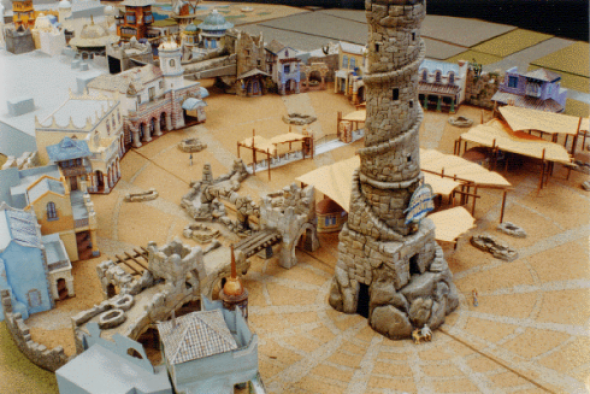 A model of the eclectic Port of Entry and the park's iconic Pharos Lighthouse. © Universal.
A model of the eclectic Port of Entry and the park's iconic Pharos Lighthouse. © Universal.
Following (and in many ways, exceeding) Disney’s precedent, Universal’s Islands of Adventure is comprised of themed lands (or, here, Islands).
Replace turn of the century Main Street, U.S.A. with Port of Entry – a hyper-detailed, kinetic boulevard comprised of architectural styles from around the world, who've all come together to create a peaceful seaside port that’s half-1930s-serial-pulp-adventure, half whimsical fantasy. Islands of Adventure also billed itself as the first theme park on Earth with a custom-made musical score. And indeed, Port of Entry is filled with a light wind chime score, chirping seagulls, banging gongs, and crashing waves to underscore this unparalleled place, all overseen by the park’s icon – a massive, leaning, stone lighthouse whose very real white beacon shines over the whole park each night, beckoning adventurers in.
Port of Entry empties onto the red, rocky shores of the Great Inland Sea, a massive body of water that’s encircled by themed Islands as richly detailed and full of character as Port of Entry. Marvel Superhero Island, Toon Lagoon, Skull Island, Jurassic Park, Lost Continent, and Seuss Landing are each comprised of environments so rich and so detailed, they rival anything Disney has ever created (each with its own musical score to boot).
Universal’s Islands of Adventure, too, broke every rule about technology’s place in theme parks, introducing the world to The Amazing Adventures of Spider-Man, still considered by many to be the best dark ride in the world, and adding shows that surpassed any industry standard like Poseidon’s Fury, a mix of walk-through adventure and special effects show, driven by story like no Universal product ever had been.
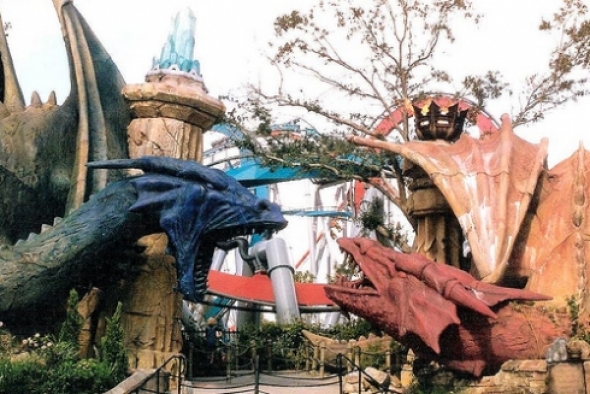 The intertwined Dueling Dragons roller coasters were a grade above Disney's thrill tolerance. © Universal.
The intertwined Dueling Dragons roller coasters were a grade above Disney's thrill tolerance. © Universal.
Islands of Adventure also went places Disney never dared – the massive launched Incredible Hulk coaster towers over Marvel Island, while the intertwined tracks of the Dueling Dragons roller coaster were host to two separate roller coasters, precisely weighed via computer so as to interact at three key points along their very different circuits, racing head-on at one another and pulling up at the very last moment.
Islands of Adventure was so ahead of its time that it coasted into the 21st century, renowned for the rest of the decade as the most technologically advanced theme park on Earth, and for good reason.
STEP TWO: Prove Yourself, Magically
Some were happy to write Universal’s Islands of Adventure as one-off success – no more than a Six Flags Park in a pretty wrapper.
Then... Harry Potter.
Disney had allegedly fought for the rights to incorporate the ultra-popular, genre-and-generation-defining Harry Potter films and stories into its theme parks, but discussions dissolved due to one or both parties (the latter party being the stories’ author, J.K. Rowling) inability to agree on a number of terms.
Universal caught the rebound. In summer 2010, The Wizarding World of Harry Potter opened as the seventh island at Islands of Adventure. With detail that folks had talked about – but not really seen in a decade – from Disney, the Wizarding World blew all expectations out of the water. Every detail was accurate. The land offered food and shopping that was absolutely perfectly oriented toward the detail Rowling and the series’ fans had insisted on. Lines to enter this one island literally stretched out of the park and across the resort on opening day.
In what can only be described as the stuff of a theme park operator’s wildest dreams, patrons lined up to enter stores. Hour long queues to purchase wands or Butterbeer – the signature drink of the series – were common. That’s to say nothing of the rides, including the massive Harry Potter and the Forbidden Journey attraction located inside a near-perfect replica of the massive, towering Hogwarts castle in which the Harry Potter series had been set. Like Spider-Man more than a decade before, the signature Harry Potter ride was technologically among the most advanced in the world, with a conveyance system of never before seen complexity that is still nearly impossible to explain.
Though Islands of Adventure alone had been a nice step, the Wizarding World cemented Universal Orlando Resort as a must-visit for many of Orlando’s travelers. Suddenly, at least a day – maybe two! – were set aside for Universal. Disney bawked that the wizard down the street hadn’t cut into their turnstile numbers. If anything, people were simply spending a few extra days in the area. One thing was for sure (if you asked them): people were not replacing a day at Disney with a day at Universal.
STEP THREE: Learn a Lesson
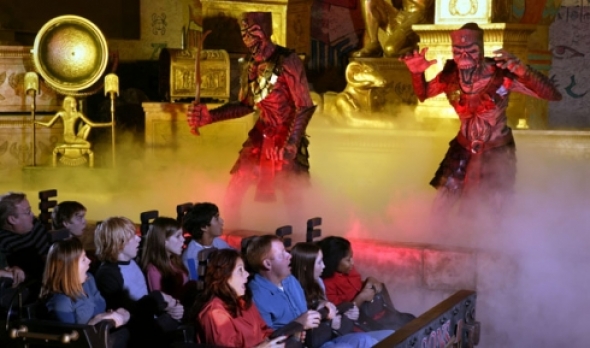 Old made way for new time and time again at Universal Studios. © Universal.
Old made way for new time and time again at Universal Studios. © Universal.
Next door to the incomparably impressive Islands of Adventure, Universal’s original park, Universal Studios Florida, was a victim of the late 1990s. Specifically, of the trend that ran rampant in that decade, necessitating the construction of “movie studio” themed parks. Universal and Disney, in fact, were head-to-head in a very public race to see who could open their studios park first. (Disney won, opening Disney-MGM Studios – now Disney’s Hollywood Studios – in May 1989, one year before Universal.)
Both parks – plagued since by their intrinsically façade-filled streets – were filled with large, boxy show-buildings, two-dimensional cutouts, and unrelated neighboring rides that, while fitting the “studios” theme, come across in today’s post-Animal-Kingdom world as cheap, flimsy, and sparse.
Universal, though, did something about it. Beginning in 2000, Universal began an aggressive and unprecedented campaign to keep their original park alive. One at a time, almost every single attraction at the park was systematically removed, with a new variation themed to a more recent film brought in. This process is, of course, a double-edged sword. Back the Future: The Ride was great in the park’s early years, and then felt a bit antiquated. Right as the ride veered back into the territory of “revered and classic,” however, it was replaced by the much more current Simpsons Ride.
Kongfrontation moved out in favor of Revenge of the Mummy, based on the 1999 blockbuster. In the constantly-shifting world of children’s entertainment, a series of motion simulators and 4D movies have occupied the park, with both recently being almost entirely rebuilt for much more permanent-feeling additions based on Despicable Me and Shrek. A massive new building was erected to house Orlando’s version of the mega-popular Transformers: The Ride – 3D that had opened in Hollywood two years prior. The construction of that ride happened in unprecedented time, with every fan and industry follower marveling over the speed and precision with which Universal worked to open the multi-million dollar dark ride that is every-bit as large-scale as Spider-Man.
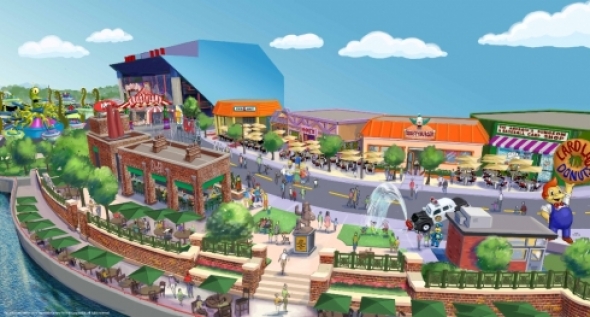 Springfield, U.S.A. brings the Simpson's home town to life. © Universal.
Springfield, U.S.A. brings the Simpson's home town to life. © Universal.
What’s more, the Studios learned a lesson from the Islands. People want more than a single ride in a show building. They want an experience. While working on that record-time Transformers construction, Universal built a themed land around the Simpsons Ride, adding stores, restaurants, and settings from the television show. Just as they’d learned from Harry Potter, folks wanted to try the Buzz Cola, Lard Lad Donuts, and Duff Beer they’d watched their favorite characters buy. The land was a hit when it opened in August, 2013.
And while building Transformers and Springfield, Universal decided to prove itself by construction a second Harry Potter area as detailed and massive as the first. This half of the Wizarding World – focused on the events from the series that take place in London and its magical Diagon Alley – take the place of the beloved Jaws boat ride, replacing it with another hyper-detailed avenue of immersive shops and restaurants with a massive dark ride / roller coaster themed to the film’s famous Gringott’s Wizarding Bank.
As well, a very real train with a very magical ride will transport guests between the original Hogwarts area of the Wizarding World at Islands of Adventure, and the Diagon Alley area of the Wizarding World at Universal Studios – the first inter-park attraction.
And of course, this second Wizarding World has whipped up just as much media frenzy and will ensure that the guests who were somehow getting away with a single day at Universal and skipping all but Potter will have to allow at least two.
STEP FOUR: Don’t Grow Crazy
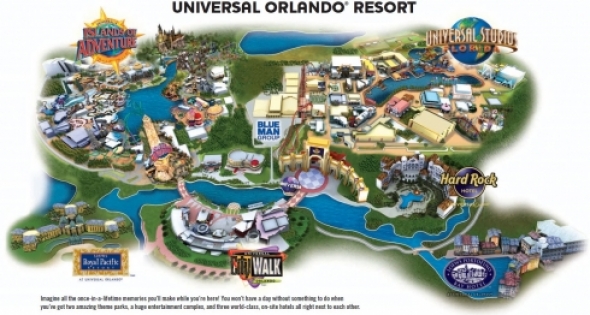 Like Disneyland, Universal Orlando's compact, cozy layout may be among its greatest assets. © Universal.
Like Disneyland, Universal Orlando's compact, cozy layout may be among its greatest assets. © Universal.
Walt Disney World has a lot of land. Universal doesn’t.
Like Disneyland, Universal used almost every acre of its free property to construct its second park. Then, it ingeniously connected the two – which reside next to one another – via a kidney bean shaped “downtown” area of its own, CityWalk. No matter how you arrive at the (renamed upon its expansion) Universal Orlando Resort, you enter into the dead center of CityWalk, passing shops, restaurants, and clubs, all constructed together (not in the organic, decade-by-decade approach that leaves Walt Disney World’s downtown area feeling disjointed and, at times, vacant).
Set loose at the bottom of the upward-curving kidney bean, you look forward to the right and see the massive white Studio Arches of Universal Studios Florida’s entrance. Forward and to the left, you see the towering Pharos Lighthouse of Islands of Adventure. It’s an interesting and palpable dichotomy, as you select which park icon to follow.
Walk toward the lighthouse and you’ll pass appropriately themed restaurants (the thatch-roofed Margaritaville and a crashed seaplane), cross a checkered bridge, and enter into that ancient Port of Entry. Walk toward the Studio Arches and you’ll brush past modern eateries and sleek shops before crossing an identical checkered bridge into the recreated Hollywood streets of Universal Studios.
 Follow Pharos Lighthouse toward Islands of Adventure.
Follow Pharos Lighthouse toward Islands of Adventure.
The entire resort is also connected via water channels, and its three (soon to be four) resort hotels reside along the channel with complimentary water taxi service bringing guests to CityWalk, unless they opt to walk the beautifully landscaped paths that dot the resort and connect everything very efficiently. (All three of Universal’s hotels, by the way, are fairly expensive. They’d be between Disney’s “moderate” and “deluxe” hotels in terms of price. Your room key, though, grants you early entry into the parks and unlimited front-of-the-line privileges at almost every single ride in the parks. Guests not staying in the hotels can purchase one-time-per-ride passes for between $30 and $70 dollars, depending on the day, which gives you an idea of the passes’ value.)
The resort is surprisingly comparable in size and scope to Disneyland Resort in California. Altogether, the tiny property is modern in every way, efficiently connected, streamlined in its transportation, home to three superior quality hotels full of perks, beautifully landscaped with Birds of Paradise and palm trees finely manicured along even the most remote paths, and exactly the right size to enjoy – no busses required.
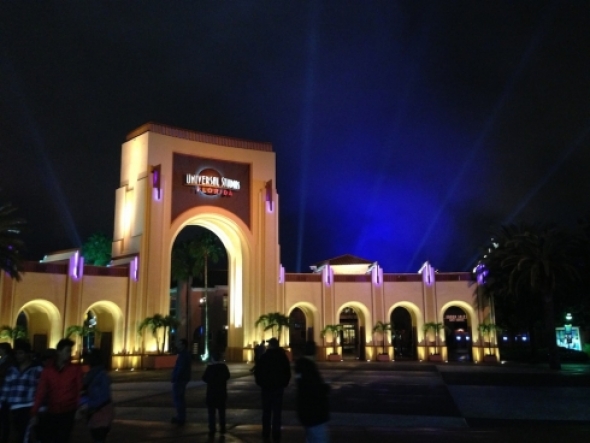
So Universal’s work is paying off in record numbers, as folks rush through the turnstiles to see the resort that this apparent underdog created overnight. What does it mean for travelers? What does Walt Disney World have at its disposal to combat whatever threat Universal may face? Does Walt Disney World worry about the growing biceps on their neighbor up the road? We’ll sum it all up in Part Three.
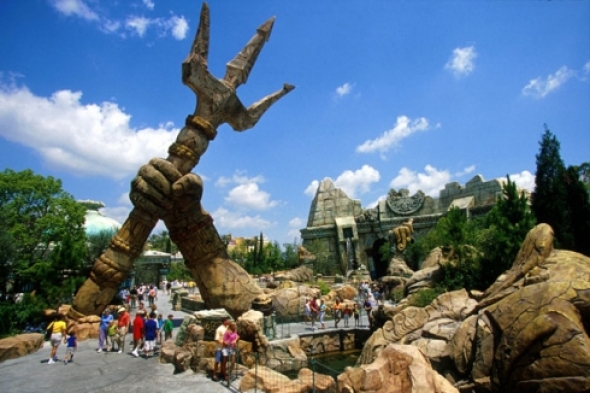
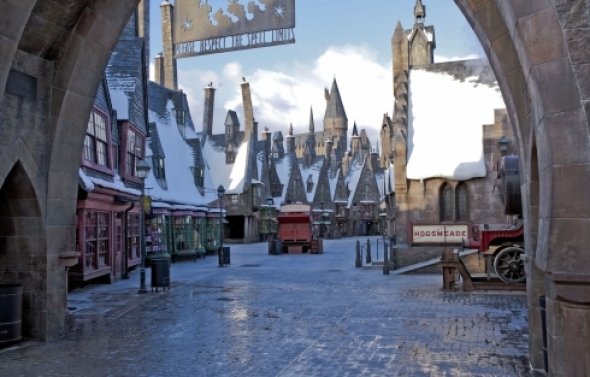
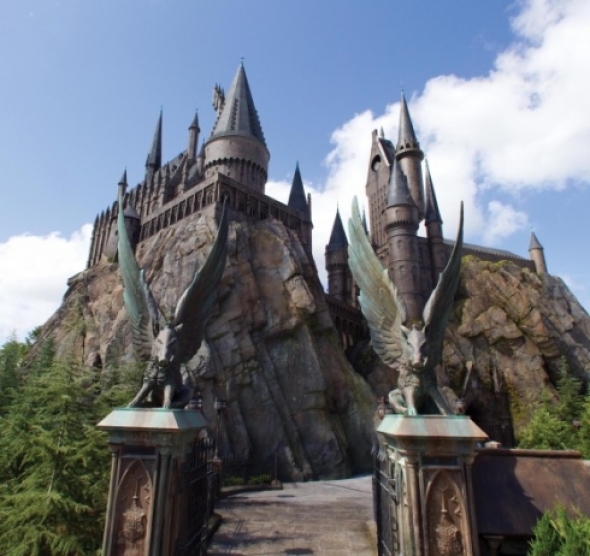
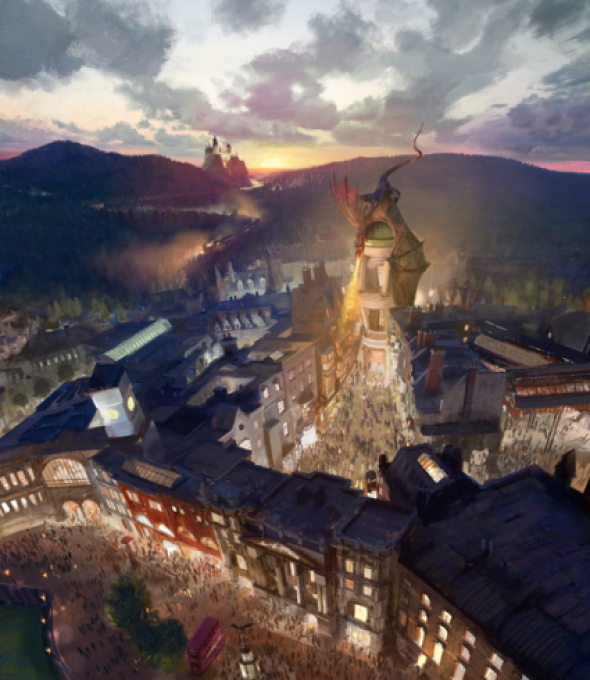

Add new comment